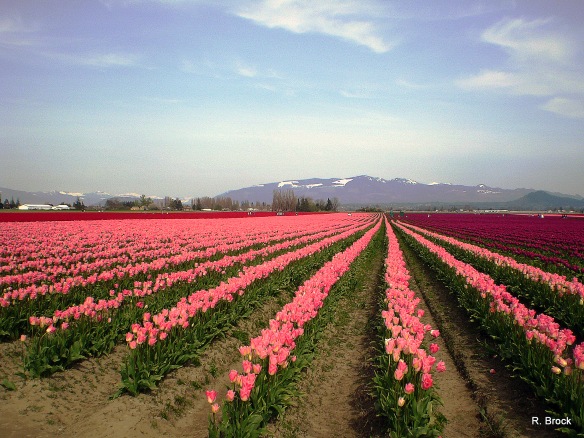
A family perusing the Bellingham tulip fields, perhaps on Sunday afternoon, all looking quite “turn of the century” to the modern eye.
With the ongoing clearing of forest lands in the early years of Whatcom County, both crop and dairy farming began to flourish throughout county, and by the 1890s a wide variety of crops were being grown here. Among those who sought to make their living off the land was one George Gibbs, who specialized in flowering bulbs. Gibbs started a bulb farm on vacant land adjacent to the former location of Fort Bellingham [Wikipedia article] where his plants soon came to flourish. Possibly inspired by Gibb’s success, in 1907 the United States Bureau of Plant Improvement set up its bulb stock on land adjacent to Gibbs bulb farm. The Holland American Bulb Company and others soon followed suit, and Whatcom county experienced a scaled-down, American frontier version of Dutch “Tulipomania.” During this period Bellingham’s collective tulip farms comprised many tens of thousands of bulbs. Such was the fervor for tulips locally and regionally that in May of 1920 the city of Bellingham organized the first Tulip Festival, highlighted by a grand parade, the crowing of Tulip princesses and a Tulip queen, as well as other civic celebrations.
All was proceeding well with Bellingham’s burgeoning bulb industry, when in 1929, the county experienced an unusually prolonged visit of the infamous “Northeaster,” a bitterly cold wind that sometimes assaults Whatcom county as a frigid continental air mass finds its way out of the interior of Canada and through the Fraser River Canyon, exiting the landform just north of Sumas and flooding across the County. A strong Northeaster typically brings with it plunging temperatures, raging winds (accelerated by a “Venturi effect” in the Fraser River Canyon) and sometimes dangerously low wind chill factors. The hard freezes caused by these intrusions of arctic air killed off the 1929 bulb crop, and the industry was forced to relocate to the Skagit Valley, where the farmland, rich with silt from the Skagit river, supported the industry without the omnipresent danger of hard freezes in winter. Today, as all locals know, Skagit Valley remains the center of the bulb industry in the Northwest, and in fact is famous worldwide for its fields of tulips, daffodils, and irises, drawing people from all over the world to visit the fields during Skagit Valley’s annual Tulip Festival in April.




